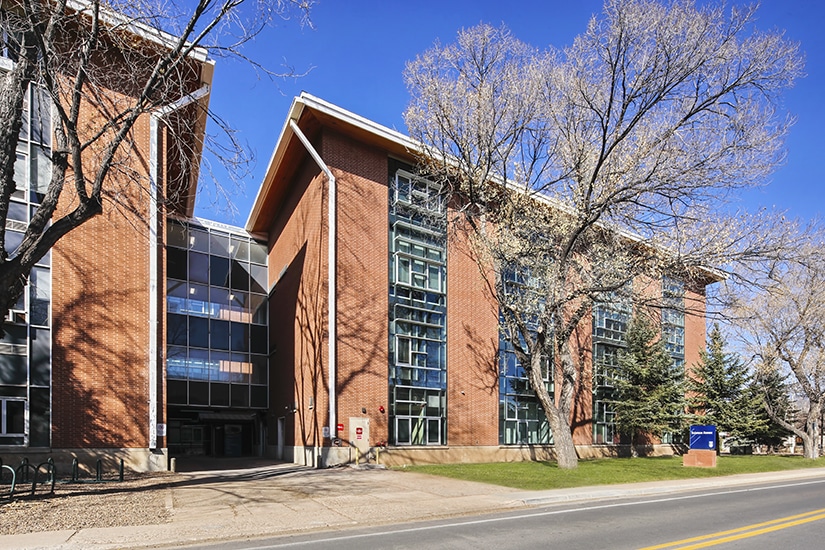|
Getting your Trinity Audio player ready...
|
A university education generally produces a degree of one specialization or another. But the full experience of higher learning includes synthesizing information from many quarters and disciplines. The whole is greater the sum of its numerous varied parts.

Daniel Okoli, the vice president of capital planning and campus operations at Northern Arizona University (NAU), applies this idea to the school’s stunning campus in Flagstaff. Situated at the edge of the Colorado Plateau, along the edge of the largest contiguous ponderosa pine forest in the lower 48 states, it is 7000 feet above sea level and among the tallest mountains of the Grand Canyon state.
In other words, the physical environment at NAU cannot be separated from its educational mission. How the campus operates, and how students, faculty, and staff traverse its footprint—which is about 1.7 miles long and 0.72 miles wide at the widest section—and how campus grounds and buildings encounter a changing climate, all have an impact on learning.
All of that falls into the hands of Okoli. All the pieces, the modes of travel, and the buildings themselves, have to fit and make sense. Fortunately, the VP has a plan and a process.
“We ask as we grow, ‘Where do we grow and yet expand within the existing footprint?’” Okoli explains. “Everything is connected: our use of energy and sustainability in particular, but also the most strategic use of existing space. The most sustainable building is the one never built.”

NAU already has more than a dozen LEED-certified buildings with a mandate that all new buildings meet at least LEED Silver standards. The operations of the campus are green as well. For example, the university has piloted both wind and solar energy, and students and staff collect more than 300,000 pounds of compostable material annually.
But that long stretch of the 600-acre campus, with north, south, and central nodes, means that transportation factors into considerations of sustainability and functionality. Cars are one option. But buses run the route every five minutes during peak times, and a bike share program enables people to choose that mode on a whim. Pedestrian-friendly sidewalks are ample and accessible, plus a pedway system (adjacent bike-walk infrastructure) is being reconstructed that provides a central organizing system for the campus master plan.
And for the student who can’t fit in a trip to a dining hall, NAU is among the first college campuses to employ electrically-powered Starship delivery robots. Bringing nutrition on demand in a smart, sustainable way that proved instantly popular, it’s now on several dozen campuses.

“On foot or bicycle is the best way to travel across campus,” explains the NAU Flagstaff Campus 2010 Master Plan. The plan was first conceived prior to Okoli’s arrival in 2017, and is now the foundation of a new comprehensive, sustainable, smart campus master plan that is in the early stages of development. Okoli explains how the shared bike-pedestrian pedways are enhanced with art, vegetation, and a cohesive signage program that “really makes it work.” One of the proposed buildings on campus (in design), a STEM research building, is situated next to a pedway to specifically enable it to be a nexus for a collection of existing science buildings nearby.
Perhaps overlooked by students and faculty alike is how the campus planning has to account for the presence of wildfires in the region. This means locating pine trees a sufficient distance from the buildings and using nonflammable materials in construction, such as brick, stone, and slate.
To implement the master plan—and adapt it as need be—Okoli stresses the importance of making students a central focus. For example, for any mode of transportation to be effective on this elongated campus, the class scheduling has to make it possible to get from one end to the other in time to be seated for a lecture or lab.

It’s part of the broader philosophy of this campus planner and architect, who holds multiple degrees himself (a bachelor’s, two master’s, and a PhD). He’s also previously served in similar roles at three other universities: Ohio State, Pace, and University of Wisconsin–Madison. “When we say it’s student-centric, it means we are always thinking about how students experience the campus,” he says. “I did a mini-study to understand students’ sense of place. Students and working professionals see it somewhat differently, with students having different functional needs.”
Okoli’s degrees cover a lot of ground—architecture, African and African American studies, and a PhD in higher education leadership with administration. This too is synthesized into campus planning and design. “For a university to be stronger, you have to leverage the strengths of everyone,” he says. For him, that means working with a team of people he describes as “great—because we use data to make informed decisions, we focus on efficiency, and we encourage people to bring us their ideas. We do this together.”


